Workout Notion Template: Planner and Tracker
This template helps you keep track of your workouts and calculate your performance per exercise, date, and training session. It works well for both weightlifting and bodyweight exercises. Let's take a look at its features and how they work.
The Core of the Template
Our gym template is based on three databases: 📅 Planner, 🏋️ Exercises, and 📝 Sets.
- A page in 📅 Planner is a group of 🏋️ Exercises assigned to a specific date.
- 🏋️ Exercises is a library of the most popular gym exercises. You can either pick the exercises you want to perform from this library or add your own. It also serves as an intermediary between 📅 Planner and 📝 Sets to aggregate training statistics.
- 📝 Sets is where you log sets by 🏋️ Exercises. It also calculates your total performance by exercise (volume).
Introducing Training Volume
To improve, you should focus on progressive overload. This means gradually increasing the weight you're lifting or the number of reps you're doing over time to increase your workout volume. Training volume is a great metric to measure your workout performance. It displays how much work you did in a single number.
Workout volume refers to the total amount of weight lifted during a workout or exercise. It is typically measured as the product of the number of sets, reps, and weight lifted. For example, performing 5 sets of 10 reps with 10kg results in a volume of 500 (5*10*10).
We use volume calculations for a single exercise (sum of sets) and for a workout (sum of exercises). The main numbers to track are Best - your personal best for the exercise or workout, and Volume - your current progress.
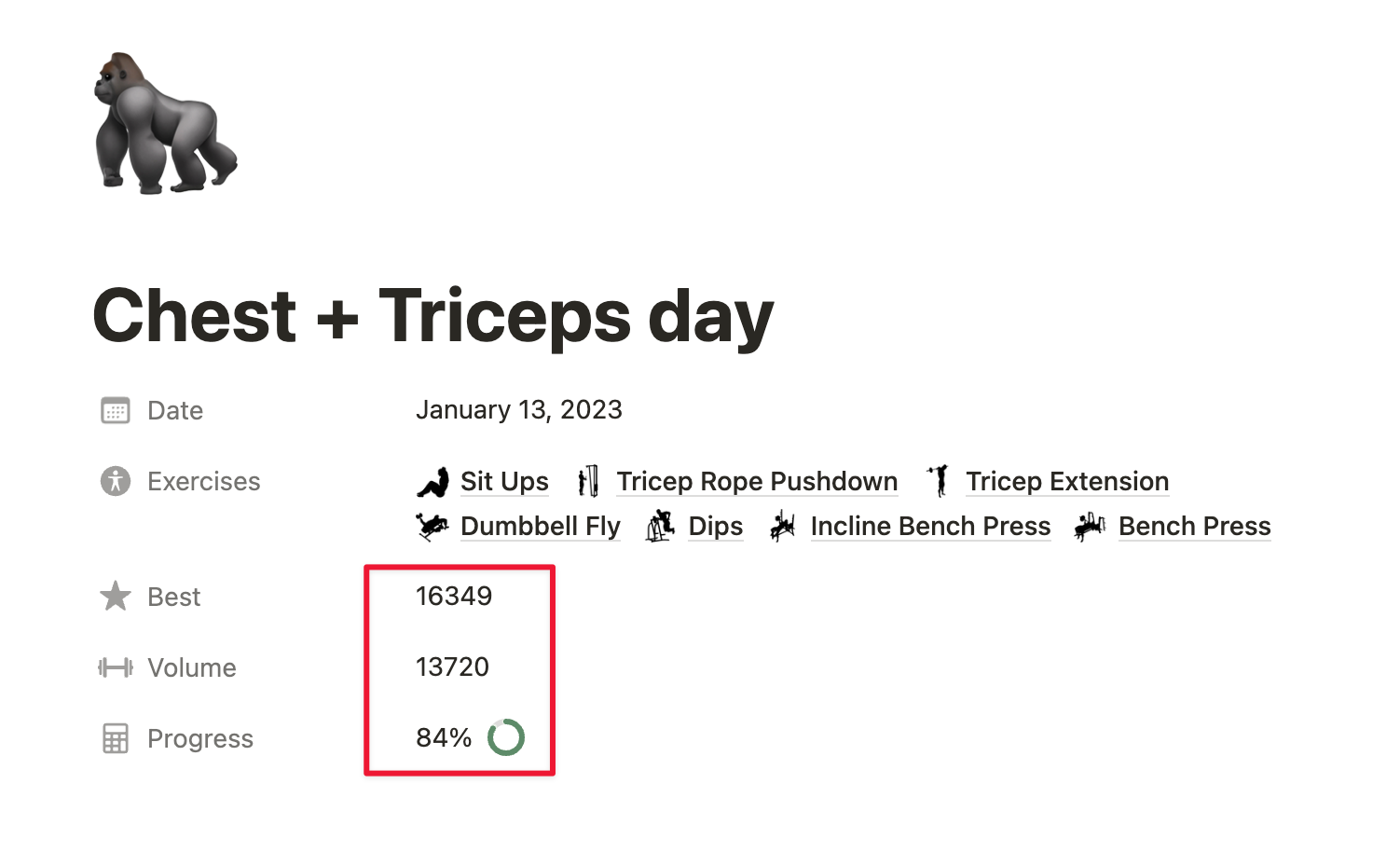
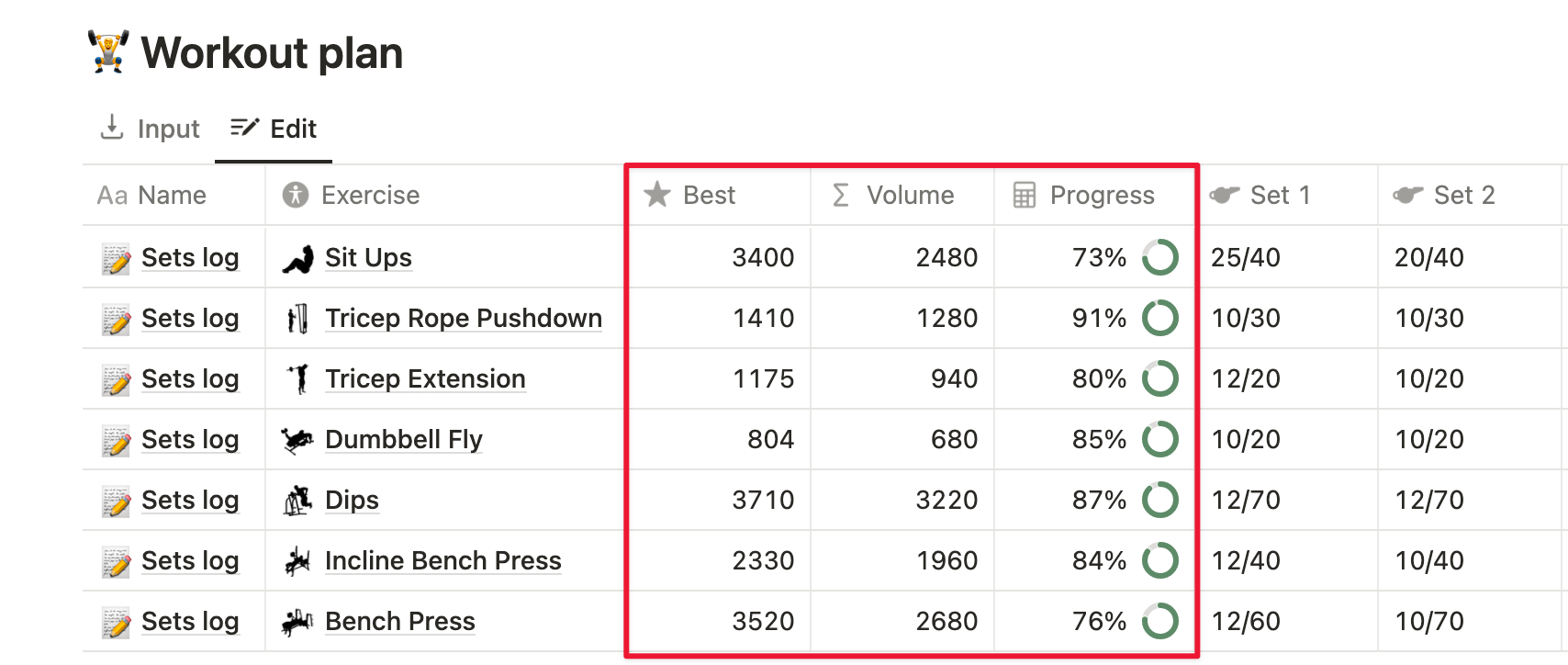
Notice on Using Workout Volume
It's important to avoid treating the amount of work as an absolute value. For example, doing a bench press set of 1000 volume (10 sets of 10 reps with 100kg) is not the same as doing 1000 volume with chest flys (imagine doing 10 sets of 10 reps with 2x50kg dumbbells). The amount of force that muscles need to overcome depends not only on the weight but also on its leverage.
Torque is calculated by М = F*R, where F is force and R is radius. In the case of a workout, joints act like axles and perform rotational motions while the force is the weight.
In the example of the bench press, the radius or leverage is the length of the arm from the shoulder to the elbow (Picture 1). However, in the case of the chest fly, the leverage is about 2x bigger, from the shoulder to the fist (Picture 2).

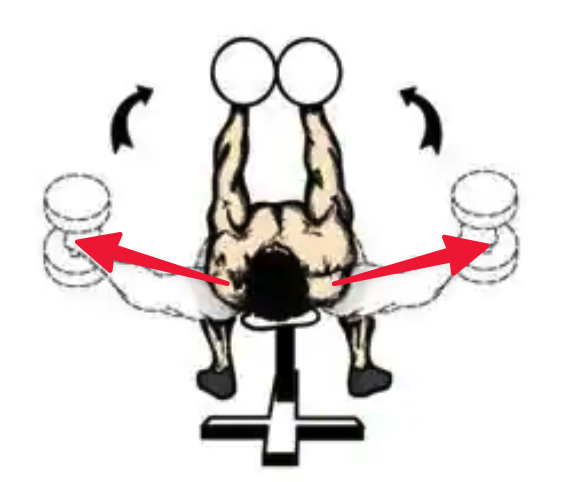
This means that for the chest fly exercise, the same weight requires twice as much work to be done by your chest muscles, and thus twice as much volume. However, tracking this can be complicated, so we will use the volume measurement only to compare sets of the same exercise.
The point of volume to beat your previous best in each exercise and/or workouts that contains of same exercises.
Continuing with our examples, let’s imagine a chest day workout that looks like it.

The total volume of bench press is almost four times greater than dumbbell flys. However, this does not mean that bench press is four times easier. It is incorrect to compare the volumes of two different workouts because each exercise engages muscles differently. Instead, you should:
- Compare volume by exercise.
- Compare volume by identical drills.

For instance, if I have 2 chest days with exact same exercises, it’s fair to say that I worked harder on the 2nd workout.
Exercise library
This database contains the top 150 exercises ranked by popularity from the Strength Level app. It also specifies the target muscle group and required equipment, allowing you to easily combine exercises into a workout or replace them. For example, if there are no free barbells at the gym, you can easily switch to a cable alternative.
Regarding metrics, it stores your all-time volume and personal best per each exercise.

Workout planner
To plan a new workout, create a new page in a calendar view and choose from pre-set templates of workouts. It works based on Advanced button functionality: all exercises are built in it.
Creating Custom Workout Templates
If you want to create a custom workout template preset or impovised training, follow these steps:
- Duplicate the 🧩 Builder template to create a new template or apply it for a single training.
- Go to Fill exercises button settings
- Select exercises you want to perform in actions settings
For example, let's create a Shoulders Day template.
Logging sets
If you have a preset for workout, use the Fill exercises button. After that just record the weight and the number or reps (or vise versa, it doesn’t matter). Use the divider / between two numbers.
Mobile best practices
Since you will most likely use your phone to log your sets, we are using the / character, as it is available on the keyboard with numbers and symbols. This way, you don't have to switch between different keyboards.
If you prefer another divider (such as x or *), you will need to adjust the formulas accordingly.
I recommend opening each set in full screen as you'll be doing exercises sequentially. This approach helps maintain focus and allows you to see all controls on a single screen. Once you've completed an exercise, navigate back to the workout page and move on to the next one.
Progress Tracker
Tracking workout progress is essential for achieving long-term fitness goals. It helps monitor the effectiveness of your workouts, measure performance, and adjust routines when needed.
Workout Tracker
To track your progress when doing the same workout drill regularly, check the Planner or Workouts views. They both contain the total volume of all exercises, so you can easily see your progress at a glance.
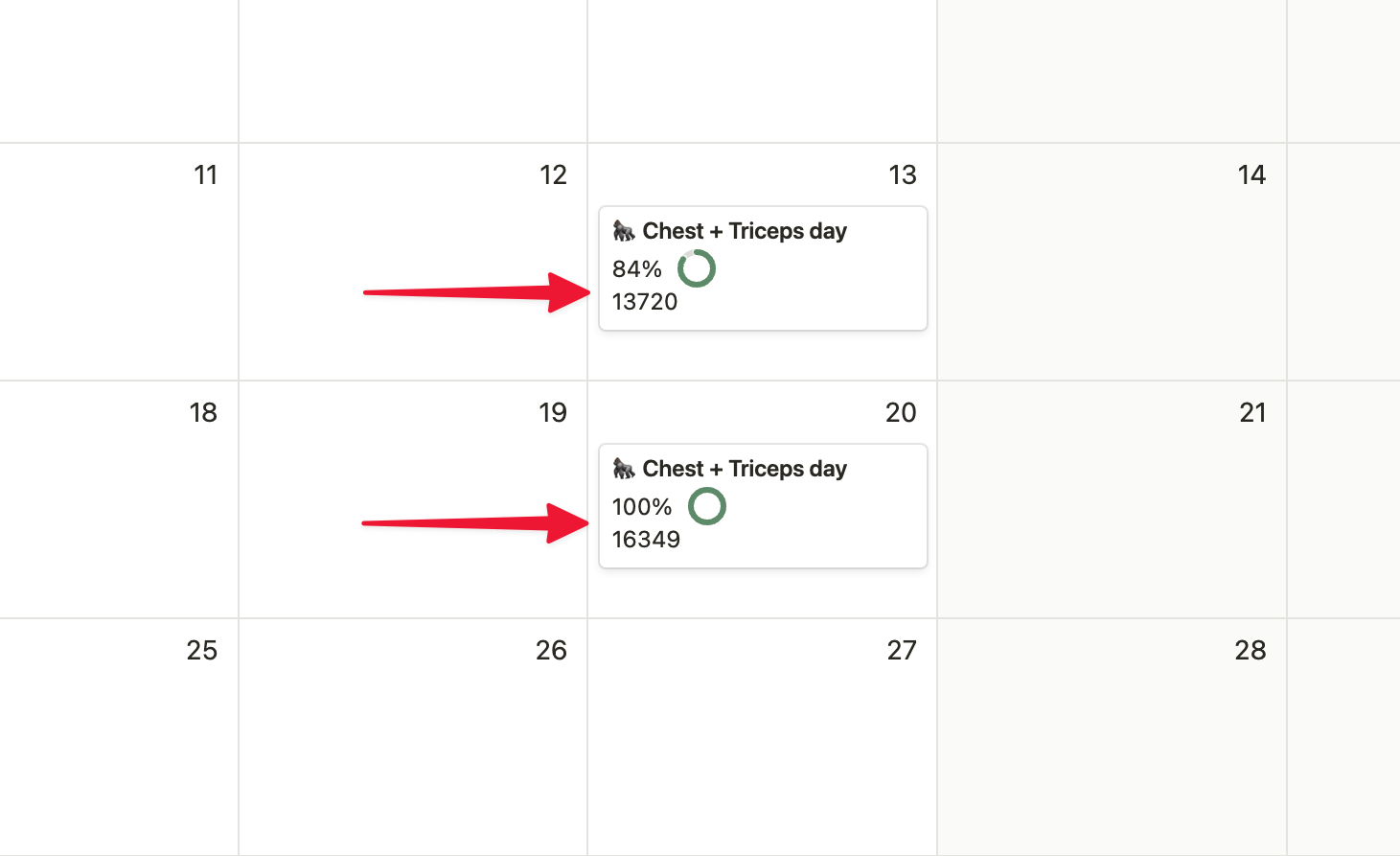
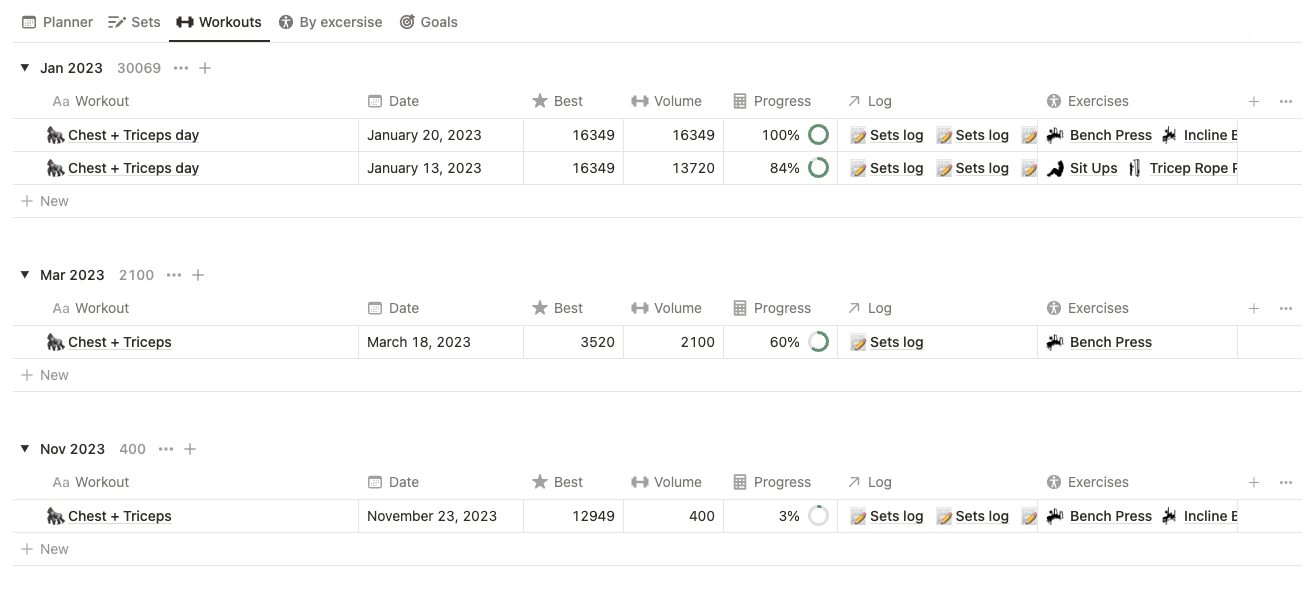
In this example, you can measure an improvement of 16% compared to your previous workout.
Exercise Tracker
To see your performance by exercise, navigate to a specific exercise in the 🏋️ Exercises database. In addition to images, the database contains two toggles: Past Sets and Workouts. These tables display the history of sets and workouts associated with an active exercise.
From the Past Sets section, you can monitor your overall training volume performance and analyze each set individually.
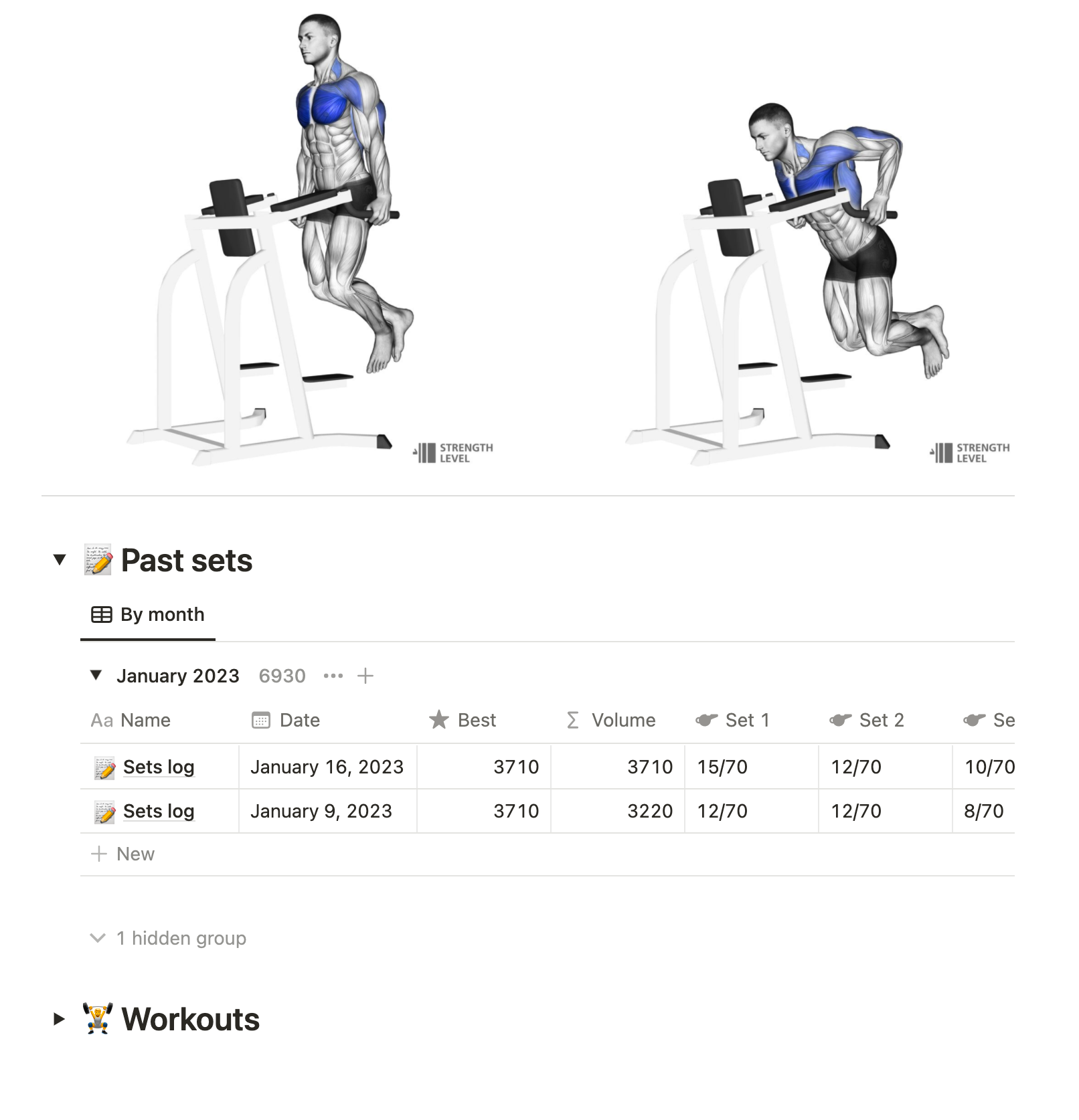
Alternatively, you can view the stats for each exercise in a table format from the main dashboard. To see progress by each exercise, navigate to the By Exercise tab.
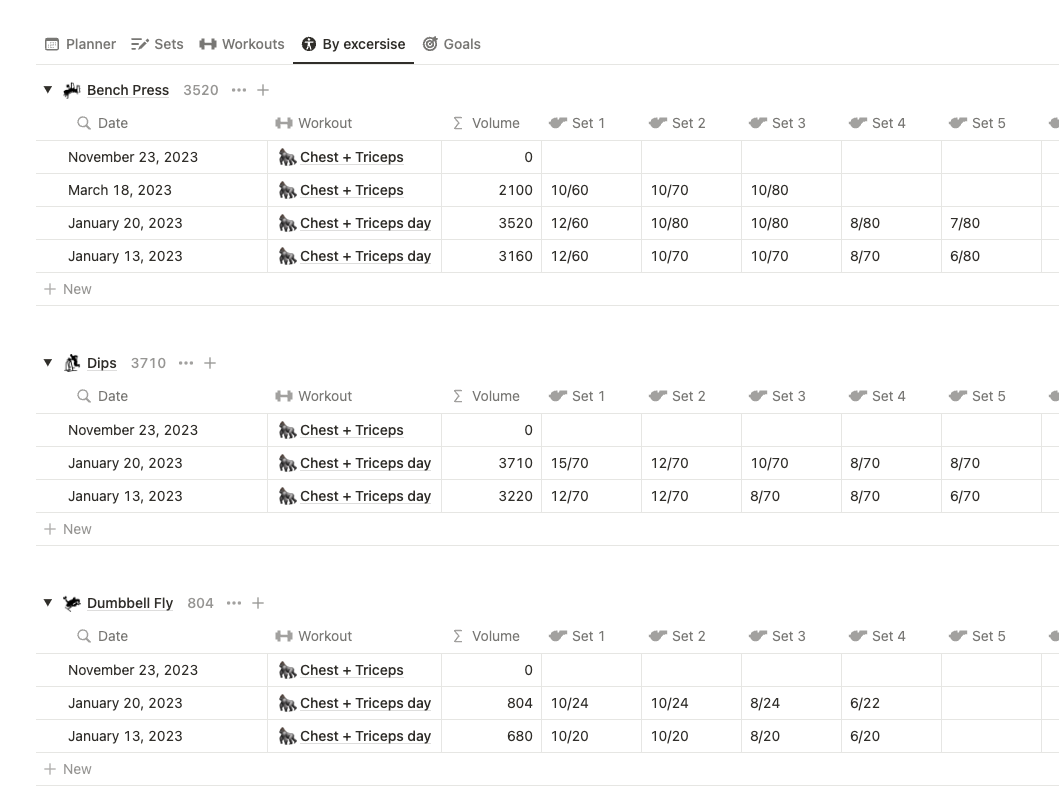
Last but not least, you are able to see you personal top of exercises in the 🏋️ Exercises page. Items here are sorted by total volume, meaning the top-1 exercise is actually the exercise you are doing the most.

Muscle group performance
It's important to spread your workouts across all muscle groups to ensure that your entire body receives a workout. This helps to prevent overtraining certain muscles and ensures that your body is strong and balanced.
To take a data-driven approach, navigate to the 🏋️ Exercise database and collapse all muscle groups. Next to each group name, you'll see a number representing the total volume of workouts you've logged for that group. If there are large discrepancies between the numbers, you may want to adjust your workout routine accordingly.

Goals
🎯 Goals is a simple database containing your long-term goals you are trying to accomplish in fitness and heath.
It works in both ways, whether you want to increase or decrease something.
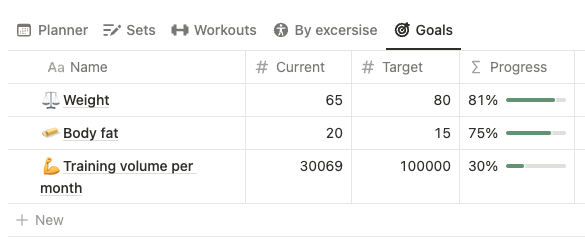
Wrapping up
Workout template for Notion is a simple, yet powerful tool for planning and tracking your workouts. Schedule your trainings in 📅 Workout planner, configure them using the 🧩 Builder template, and record each set in the 📝 Sets log. The tool automatically tracks your stats in the background: you can check your progress at any time. Be strong and good luck 💪
Properties manual
🏋️ Exercises
Property |
Type |
Description |
|---|---|---|
| Record for formula | Formula | A formula that stores value of Best to send it to 📝 Sets to display your personal best there and calculate progress. Workaround for rolluping the rollup. |
| Log | Relation | A relation to 📝 Sets database. |
| Sum volume | Rollup | Sum of Volume in 📝 Sets database. Indicates how much work you did within the exercise. Used before Popularity in sorting so exercises you are logging would appear at the top. |
| Popularity | Number | A relative popularity of exercise to apply sorting so the most popular exercises appear at the top. |
| Best | Rollup | Pulls a max value of Volume in 📝 Sets database |
| Finish image | File | An endpoint image of exercise used for card preview in board view. |
| Equipment | Select | An equipment required to perform an exercise |
| Muscle group | Multi-select | A muscle group that is targeted with this exercise |
| Name | Text | A name of exercise |
📝 Sets
Property |
Type |
Description |
|---|---|---|
| Record for formula | Formula | prop("Best") Duplicates the Best property so use it for rollup in 📅 Planner database. |
| Set X | Text | Text cell that contains reps count and weight used. Reps and weight can be added in any order. Requires divider from Volume formula to split values (/ by default) |
| Progress | Formula | round(prop("Volume") / prop("Best") * 100) / 100 Similarly to Volume in 📅 Planner calculates current progress. |
| Volume | Formula | if(contains(prop("Set 1"), "/"), toNumber(replace(prop("Set 1"), "/.", "")) * toNumber(replace(prop("Set 1"), "./", "")), toNumber(prop("Set 1"))) + ... At first, it check whether the set contains divider or it’s a bodyweight exercise. If true, it splits set cell (e.g. 10/30) in two numbers and multiplies them; if false - just leaves a number. Then it sums all volumes one by one. |
| Best | Rollup | Pulls the Record for formula property from 🏋️ Exercises database to display your personal best for exercise. This is a workaround because you can’t rollup a rollup. |
| Date | Rollup | A Date rollup of a Workout the set is assigned to |
| Workout | Relation | A relation to 📅 Planner database |
| Exercise | Relation | A relation to 🏋️ Exercises database |
| Name | Text | Always a “Sets log” due to default template. If it doesn’t work, change the template from “Default” to “Sets log” in order to enable it |
📅 Planner
Property |
Type |
Description |
|---|---|---|
| Exercises | Rollup | A rollup from 📝 Sets database to display exercises within the workout |
| Log | Relation | A relation to the 📝 Sets database |
| Progress | Formula | round(prop("Volume") / prop("Best") * 100) / 100 Counts the percentage of current volume to personal best. Original value is rounded to 0.00 to be correctly displayed as percentage. |
| Volume | Rollup | Sum of Volume property from 📝 Sets to display your current progress |
| Best | Rollup | Pulls a Record for formula property from 📝 Sets to display your all-time best for all exercises within the workout. This is a workaround because you can’t rollup a rollup. |
| Date | Date | A date of the workout |
| Workout | Text | A name of your workout drill (e.g. “Chest day”) |
